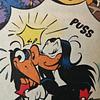Take a photo of a barcode or cover
No better time for a collection of winter-themed tales than August, right? The falcon on the cover drew me in; unfortunately, even though this book is filled with lush and enchanting descriptions, adventurous seamen and impish children, it wasn’t for me. I can hardly fault the writing. The synopsis calls them ‘tales of longing’, but a more common sentiment throughout is that of ambivalence, or even the unnaturalness of living without fear. Many of the tales intrigued me at first (‘The Young Man with the Carnation’, for example), but then they dragged on or took a turn to a place I couldn’t follow, much as if the clear narrative had somehow gone adrift in the midst of a snowstorm. Sometimes a fiction’s strangeness matches our own and sometimes doesn’t.
‘A public cannot be merciful to an artist, if it were merciful it would not be a public. […] Neither can an artist be merciful to his public, – or it has, at least, never been tried.’
in ‘A Consolatory Tale’.
‘A public cannot be merciful to an artist, if it were merciful it would not be a public. […] Neither can an artist be merciful to his public, – or it has, at least, never been tried.’
in ‘A Consolatory Tale’.
When I bought this book, I wasn't sure what to expect. I had heard of its author before: Isak Dinesen is the pen name of Danish baroness Karen Blixen, who was portrayed by a heavy-accented Meryl Streep in the 1985 Oscar-winning epic Out of Africa. Dinesen, who died in 1962, was perhaps the last great female author to use a male pseudonym.
According to John Gardner's The Art of Fiction, every work of short fiction belongs to one of three basic types: the short story (exemplified by Anton Chekhov), the yarn (exemplified by Mark Twain), or the tale (exemplified by Dinesen). Of the three types, short stories seem to have the most cultural cachet nowadays: just as literary fiction is popularly thought to be more deserving of serious attention than genre fiction, many people nowadays seem to believe that short stories have more inherent merit than tales and yarns. Certainly, the pages of today's literary magazines and anthologies are glutted with the former rather than the latter.
Well-planned, meticulously constructed, and structured like miniature gothic cathedrals, Dinesen's tales seem to have been written for the purpose of exploring weighty cosmic themes, such as the relationship between artists and God, the clash between the opposing world-views of feudalism and democracy, etc. Character and plot are unquestionably subservient to theme in these works, and I found Susan C. Brantley's academic text Understanding Isak Dinesen to be helpful for figuring out the more subtle themes. For me, only a few of these eleven tales transcended their stodgy academic contours and succeeded in wresting a visceral emotional response out of me: most notably, "Sorrow-Acre" and "Peter and Rosa." I also found the ending of "The Heroine," in which an aging female character wistfully mediates on the differing effects of old age on men and women, to be touchingly beautiful.
"The Dreaming Child," which initially seems like sentimental tosh about a Dickensian orphan but turns out to be a penetrating exposé of the shocking ways premodern women sublimated their repressed sexual feelings, may also be worth a read.
According to John Gardner's The Art of Fiction, every work of short fiction belongs to one of three basic types: the short story (exemplified by Anton Chekhov), the yarn (exemplified by Mark Twain), or the tale (exemplified by Dinesen). Of the three types, short stories seem to have the most cultural cachet nowadays: just as literary fiction is popularly thought to be more deserving of serious attention than genre fiction, many people nowadays seem to believe that short stories have more inherent merit than tales and yarns. Certainly, the pages of today's literary magazines and anthologies are glutted with the former rather than the latter.
Well-planned, meticulously constructed, and structured like miniature gothic cathedrals, Dinesen's tales seem to have been written for the purpose of exploring weighty cosmic themes, such as the relationship between artists and God, the clash between the opposing world-views of feudalism and democracy, etc. Character and plot are unquestionably subservient to theme in these works, and I found Susan C. Brantley's academic text Understanding Isak Dinesen to be helpful for figuring out the more subtle themes. For me, only a few of these eleven tales transcended their stodgy academic contours and succeeded in wresting a visceral emotional response out of me: most notably, "Sorrow-Acre" and "Peter and Rosa." I also found the ending of "The Heroine," in which an aging female character wistfully mediates on the differing effects of old age on men and women, to be touchingly beautiful.
"The Dreaming Child," which initially seems like sentimental tosh about a Dickensian orphan but turns out to be a penetrating exposé of the shocking ways premodern women sublimated their repressed sexual feelings, may also be worth a read.
I went to Denmark, pretty much, to see Karen Blixen's home. It is a beautiful place; the land around the house, including Blixen's grave, has been made into a bird santucary. The house is near the water, and at least when I went there, the walk from the train station included passing what looked to be a Nor. Fjord breeding farm. There was even a resturant with Blixen inspired art work (pricey but very nice) and excellent food.
It seems strange that when reading Blixen's non-fiction what comes across is her love for her farm in Africa, yet reading her fiction what comes across is her love for Denmark and its history. This dual love is actually reflected in her house, with its Africa interior yet its Danish exterior.
In many ways, too, the stories in this volume remind me of that house. Take for instance, "Sorrow Acre", the story that I always like the most in this volume ("The Cloak" is her best story, at least to me). The story tells of a mother's desperate attempt to save her son, yet juxaposes this with a relationship between the old lord, his wife, and his nephew, Adam. The story not only calls to mind the Danish landscape, but also Danish history for Adam had been away on a mission involving the punishment of Queen Caroline Mathlide. The Queen, wife of the insane Christian VII, had an affair with her husband's physican Johann Friedrich Struensee, some time after she gave birth to the heir. The two lovers ruled for a brief period (she has queen, he as prime minster) during which Caroline gave birth to a daughter. They lost power to Christian VII's step-mother. Struensee was execuated, and Caroline was imprisoned in Helsingor (Elisnore) castle, in what is best described as a cell before she was sent into exile in Hanover. She never saw either of her children after her imprisonment. This whole story hangs over Blixen's story and its theme of youth versus age, for the Queen and her lover were more popular than the step-mother, at least with the common people.
What also flows though these stories is the theme of the influence of art and sailoring. There are stories that resemble fairy tales, a Charles Dickens wanders though two of the stories. But there is also a sense of loss, especially in the two stories that deal with children, in particular "The Dreaming Child" and its question of who extactly is dreaming - the child, the wife or the reader? Blixen suffered a miscarriage at one point during her time on her farm (the child was Denys Finch-Hatton's). A reader has to wonder if these stories, written years after her experience expressed in some way her desire for a child. (Is the power of the wives and the weakness of the hubands a comment on her marriage?)
Perhaps it is this question that makes Blixen one of the more honest writers. At times her stories don't seem to be going anywhere, then suddenly, like much in life, something happens, a small event becomes large, something changes and the meaning becomes clear. The stories are small studies in art, the soul, the craft, and love.
It seems strange that when reading Blixen's non-fiction what comes across is her love for her farm in Africa, yet reading her fiction what comes across is her love for Denmark and its history. This dual love is actually reflected in her house, with its Africa interior yet its Danish exterior.
In many ways, too, the stories in this volume remind me of that house. Take for instance, "Sorrow Acre", the story that I always like the most in this volume ("The Cloak" is her best story, at least to me). The story tells of a mother's desperate attempt to save her son, yet juxaposes this with a relationship between the old lord, his wife, and his nephew, Adam. The story not only calls to mind the Danish landscape, but also Danish history for Adam had been away on a mission involving the punishment of Queen Caroline Mathlide. The Queen, wife of the insane Christian VII, had an affair with her husband's physican Johann Friedrich Struensee, some time after she gave birth to the heir. The two lovers ruled for a brief period (she has queen, he as prime minster) during which Caroline gave birth to a daughter. They lost power to Christian VII's step-mother. Struensee was execuated, and Caroline was imprisoned in Helsingor (Elisnore) castle, in what is best described as a cell before she was sent into exile in Hanover. She never saw either of her children after her imprisonment. This whole story hangs over Blixen's story and its theme of youth versus age, for the Queen and her lover were more popular than the step-mother, at least with the common people.
What also flows though these stories is the theme of the influence of art and sailoring. There are stories that resemble fairy tales, a Charles Dickens wanders though two of the stories. But there is also a sense of loss, especially in the two stories that deal with children, in particular "The Dreaming Child" and its question of who extactly is dreaming - the child, the wife or the reader? Blixen suffered a miscarriage at one point during her time on her farm (the child was Denys Finch-Hatton's). A reader has to wonder if these stories, written years after her experience expressed in some way her desire for a child. (Is the power of the wives and the weakness of the hubands a comment on her marriage?)
Perhaps it is this question that makes Blixen one of the more honest writers. At times her stories don't seem to be going anywhere, then suddenly, like much in life, something happens, a small event becomes large, something changes and the meaning becomes clear. The stories are small studies in art, the soul, the craft, and love.
Some stories are good, but there is a snob and sexist background that made me disconnect.
IDK if I’m lacking cultural context or just stupid but I don’t get it
adventurous
dark
mysterious
reflective
medium-paced
Plot or Character Driven:
A mix
Strong character development:
Complicated
Loveable characters:
Complicated
Diverse cast of characters:
No
Flaws of characters a main focus:
Complicated
I wasn't sure what to expect from this collection of short stories by Isak Dinesen (aka Karen Blixen, the Danish author most known for writing Out of Africa), but they were just enchanting and now I want to read everything she wrote. The stories are set in the late 19th / early 20th century, sometimes in Denmark, but not exclusively. They have a fairytale / fable otherworldliness to them and her skill with quickly building the world of story and surgically precise and crisp descriptions make each story unique and engaging. Dinesen was in her mid-50s when these were published in 1941 during the Nazi occupation of Denmark, and several of the stories resonate with that moment in history. Highly recommended.
Gorgeous language and crystalline images, so delicate that it felt as if they could disappear so easily, like lucid dreams. But eventually it became tiresome and the fairy-tale quality began to feel like a formula. A few stories still stick with me, though, especially "Sorrow-Acre" and "The Dreaming Child".
It felt like an accomplishment finishing this short story collection, and I really did enjoy it despite how long it took to finish!! Each story was richly told, allegory heavy, and often had a story within a story so it wasn't light reading. I loved that some of these would ever so slightly bend towards fantasy supernatural in the tiniest ways, and almost all of them were based around Danish history and values. I can't actually pick a favorite now, and I think I'll have to sit a little longer with these stories to know how I feel about all of them. This was definitely outside my comfort zone, but absolutely worth diving into the completely foreign scenes that Dinesen creates.
While I absolutely loved Isak Dineson's (or Karen Blixen in real life) autobiographical tale "Out of Africa," her novel "Winter's Tales" really paled in the comparison. I found these stories -- mostly with a simplistic moral message to be extremely hard to read. It really came off like high school poetry -- an effort to be pretentious and deep that years later just reads as silly. Definitely avoid this book and read "Out of Africa" instead.





